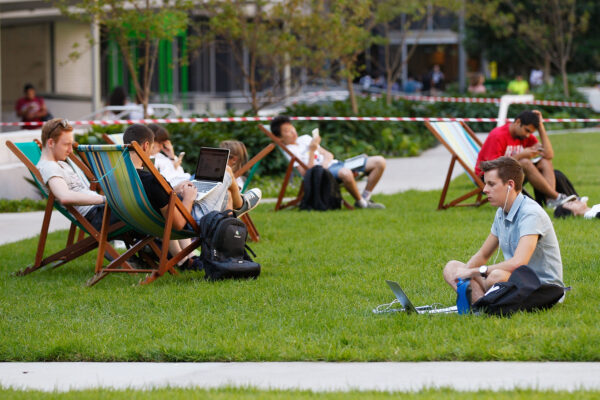Beijing’s Online Study Ban Has Not Brought Expected Chinese Student’s Visas Boom to Australia
Australia’s Home Affairs Department has confirmed there has been no significant increase in the number of visas issued to Chinese students despite the Chinese regime’s recent ban on online learning, forcing students to return to foreign universities around the world. During a Senate hearing on Feb. 13, the Home Affairs Department confirmed that it had issued visas to over 40,000 Chinese students to allow them to return to Australian universities to study. The department said there was a slight rise in daily visa application rates since the Chinese regime announced the ban in late January. Still, it noted the situation was not of concern nor required priority. “We’re continuing to look closely for a surge, but one isn’t apparent at this time,” senior immigration official Michael Willard told the Senate estimate committee on the night of Feb. 13. At the same time, Willard said the education department was discussing the original online learning ban order and subsequent announcements with the Chinese authorities. The Home Affairs Department’s remark comes as Australia has seen a substantial drop in overseas Chinese students coming to the country compared to the pre-COVID-19 period. According to government data, there were 78,234 Chinese student visa holders in Australia in September 2022, down 53 percent from 165,149 visa holders in September 2019. On Jan. 28, the Chinese Service Center for Scholarly Exchange, a national institution affiliated with China’s Education Ministry, announced that from the first semester of 2023, the centre would no longer recognise overseas diploma certificates obtained through remote study. The announcement effectively reverses the centre’s previous policy, which allowed Chinese students enrolling at foreign universities to study online during the COVID-19 pandemic. The centre said the new policy was made to “protect the interests of students who receive overseas education and maintain the fairness of education.” A general view of the University of Technology Sydney campus in Sydney, Australia, on April 6, 2016. (Brendon Thorne/Getty Images) However, the abrupt decision has put tens of thousands of Chinese students and their families off guard, forcing them to scramble back to Australia as the first semester of 2023 would start in a few weeks. While the Australian education sector believed the change would bring about significant economic benefits for local education providers, it expressed concerns that the new policy would put overseas Chinese students in a difficult situation. “We are concerned at the bluntness of this decision, and we will seek urgent advice and clarification from the Chinese Embassy on what special circumstance provisions are available,” said Vicki Thomson, chief executive of The Group of Eight universities. “Final year students who stuck with us throughout the COVID years may now need to return urgently, secure accommodation, and obtain a visa within a few weeks–an almost impossible task.” Meanwhile, Chinese students have taken to the internet to vent their frustration as they have to deal with many issues in the aftermath of the regulation, from visa applications to skyrocketing flight tickets and severe housing shortages in major Australian cities. Chinese Students’ Return Exacerbates Rental Crisis in Australia As more and more Chinese return to Australia, rental markets across the country are under increasing pressure to meet their demand for housing, deepening the crisis facing many Australians. According to the property marketplace website Domain, the national rental vacancy rate fell to a record low of 0.8 percent in January, with the level in Sydney and Melbourne, the two major destinations for international students, dropping to one percent. In terms of prices, real estate data provider CoreLogic reported that rent jumped by 10.2 percent on average across the country in the 12 months to Dec. 31, 2022, with Sydney and Melbourne recording a growth of 11.4 percent and 9.6 percent, respectively. People study at the University of Technology Sydney campus in Sydney, Australia, on April 6, 2016. (Brendon Thorne/Getty Images) Property experts have warned that the return of 40,000 Chinese students will worsen the national rental situation, which is already stretched. “Unfortunately, specialist student accommodation is already tight—there are zero vacancies in some cities such as Brisbane, while other centres are filling up fast,” said Torie Brown, an executive director in charge of student accommodation at the Property Council of Australia. “We are talking about 40,000 students coming back into the market. And that is just students from China. We also have students returning from all over the world,” Brown said. Building more student accommodation is one way to alleviate pressure from overseas students’ housing demand. However, the executive said there was not much development due to a lack of local investment in student housing an

Australia’s Home Affairs Department has confirmed there has been no significant increase in the number of visas issued to Chinese students despite the Chinese regime’s recent ban on online learning, forcing students to return to foreign universities around the world.
During a Senate hearing on Feb. 13, the Home Affairs Department confirmed that it had issued visas to over 40,000 Chinese students to allow them to return to Australian universities to study.
The department said there was a slight rise in daily visa application rates since the Chinese regime announced the ban in late January. Still, it noted the situation was not of concern nor required priority.
“We’re continuing to look closely for a surge, but one isn’t apparent at this time,” senior immigration official Michael Willard told the Senate estimate committee on the night of Feb. 13.
At the same time, Willard said the education department was discussing the original online learning ban order and subsequent announcements with the Chinese authorities.
The Home Affairs Department’s remark comes as Australia has seen a substantial drop in overseas Chinese students coming to the country compared to the pre-COVID-19 period.
According to government data, there were 78,234 Chinese student visa holders in Australia in September 2022, down 53 percent from 165,149 visa holders in September 2019.
On Jan. 28, the Chinese Service Center for Scholarly Exchange, a national institution affiliated with China’s Education Ministry, announced that from the first semester of 2023, the centre would no longer recognise overseas diploma certificates obtained through remote study.
The announcement effectively reverses the centre’s previous policy, which allowed Chinese students enrolling at foreign universities to study online during the COVID-19 pandemic.
The centre said the new policy was made to “protect the interests of students who receive overseas education and maintain the fairness of education.”

However, the abrupt decision has put tens of thousands of Chinese students and their families off guard, forcing them to scramble back to Australia as the first semester of 2023 would start in a few weeks.
While the Australian education sector believed the change would bring about significant economic benefits for local education providers, it expressed concerns that the new policy would put overseas Chinese students in a difficult situation.
“We are concerned at the bluntness of this decision, and we will seek urgent advice and clarification from the Chinese Embassy on what special circumstance provisions are available,” said Vicki Thomson, chief executive of The Group of Eight universities.
“Final year students who stuck with us throughout the COVID years may now need to return urgently, secure accommodation, and obtain a visa within a few weeks–an almost impossible task.”
Meanwhile, Chinese students have taken to the internet to vent their frustration as they have to deal with many issues in the aftermath of the regulation, from visa applications to skyrocketing flight tickets and severe housing shortages in major Australian cities.
Chinese Students’ Return Exacerbates Rental Crisis in Australia
As more and more Chinese return to Australia, rental markets across the country are under increasing pressure to meet their demand for housing, deepening the crisis facing many Australians.
According to the property marketplace website Domain, the national rental vacancy rate fell to a record low of 0.8 percent in January, with the level in Sydney and Melbourne, the two major destinations for international students, dropping to one percent.
In terms of prices, real estate data provider CoreLogic reported that rent jumped by 10.2 percent on average across the country in the 12 months to Dec. 31, 2022, with Sydney and Melbourne recording a growth of 11.4 percent and 9.6 percent, respectively.

Property experts have warned that the return of 40,000 Chinese students will worsen the national rental situation, which is already stretched.
“Unfortunately, specialist student accommodation is already tight—there are zero vacancies in some cities such as Brisbane, while other centres are filling up fast,” said Torie Brown, an executive director in charge of student accommodation at the Property Council of Australia.
“We are talking about 40,000 students coming back into the market. And that is just students from China. We also have students returning from all over the world,” Brown said.
Building more student accommodation is one way to alleviate pressure from overseas students’ housing demand.
However, the executive said there was not much development due to a lack of local investment in student housing and a stand-off among investors in the residential rental market.
“We can’t get local investors into student accommodation. The big super funds do not go near it though they are willing to enter this area in other markets such as the UK and Canada,’ Brown said.
“In our market, the money is almost entirely from offshore investors.”
Cindy Zhan contributed to this article.












